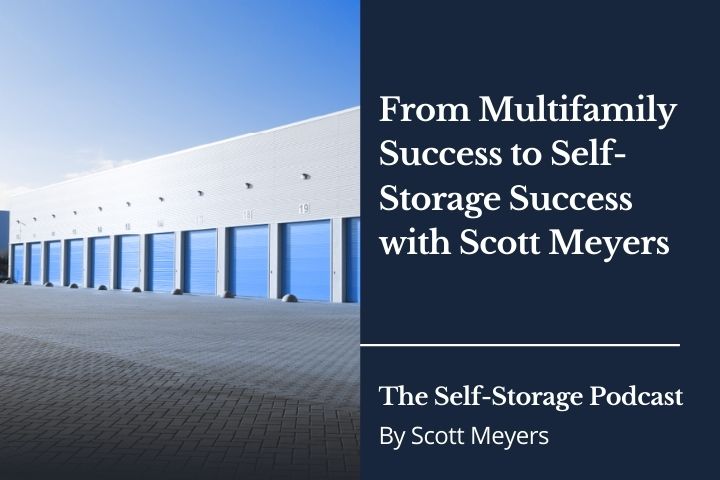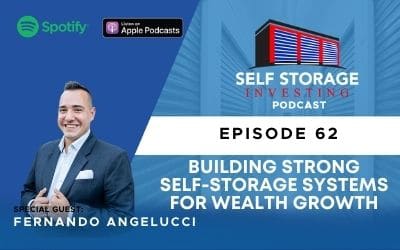With 2024 just around the corner Scott takes the time in this episode to answer some of the most frequent questions he gets. Questions include success stories, how to analyze market trends (and what Scott sees happening in 2024), tax benefits, getting a real understanding of what creative financing really means, and how technology is changing operations.
WHAT TO LISTEN FOR
4:09 Success Stories in Tough Markets
11:28 Understanding Value-Add Components in Self-Storage Facilities
13:59 Creative Financing Strategies
22:42 Leveraging Technology to Enhance Operations
Leave a positive rating for this podcast with one click
CONNECT WITH US
Website | You Tube | Facebook | X | LinkedIn | Instagram
Follow so you never miss a NEW episode! Leave us an honest rating and review on Apple or Spotify.
Episode Transcript
Announcer (00:07):
This is the Self Storage Podcast where we share the knowledge and skills from the industry’s leading investors, developers, and operators to help you launch and grow your Self storage business. Your host, Scott Meyers, over the past 18 years has acquired, developed, converted, and syndicated nearly 5 million square feet of Self storage nationwide with the help of his incredible team at Selfstorageinvesting.com, who has helped thousands of people achieve greatness in Self storage.
Scott Meyers (00:42):
Hello everyone, and welcome back to the Self Storage Podcast. I’m your hostess, Scott Meyers, and well here we are. It is at the end of 2023, although a fantastic year. We are poised and ready for 2024, and so we’ve got a great lineup for 2024 with incredible guests topics series, and we are going to be taking it to the next level. You will see a different podcast, Self-Storage Nation from us in 2024. Looking forward to bringing that to you as well. But we thought the best way to be able to maybe cap off what has been a great year in the self-storage is to once again go back to the mailbag to celebrate some successes, answer some questions, and then also there are a lot of questions. We’ve had a lot of questions as to, alright, Scott, what is your take on 2024 and what should we expect? Rate the year from a one to 10 and or get the crystal ball out. And so, although my crystal ball is in the shop, as we said several times before, recent information that has come to light has us really bullish on self storage. And so with that, everybody, welcome to the show, my friend, our host, our producer, Doug. Doug, welcome back.
Doug Downs (01:47):
Good to be back. Good to be back. And I got to think you’re bullish. You’re inserting the masterclass December 28th, which is getting people geared up for 2024 as one bar chart goes down the market, another one maybe goes up the opportunities in self-storage.
Scott Meyers (02:06):
It does. And so I just got back from a mastermind that I’m a part of. We have our own mastermind with a whole bunch of rock stars in self storage, but then I’m a part of a larger real estate mastermind with folks that are in all aspects and all asset classes of self storage. And this group is a very, very large, it’s a mastermind that’s been around for quite a while and we pay a hefty fee to be a part of it. But the good news is that the ROI is that we get to pay to have some incredible speakers and economists and experts on the other side, the mortgage side, on the financial side, to be able to guide us and really see a little further down the road, some folks that are tied in a little closer, not that anybody’s tied in with the feds, but they understand and they know where to get their information from and their data to help us make better decisions. And so yes, we were treated to a whole dose of predictions and for 2024, that has us all pretty excited. So we’ll get into that a little bit more and share that with everyone. But yeah, as you can see, Doug, we’re pretty excited about our prospects in 2024.
Doug Downs (03:09):
And that masterclass you’ve got coming up on the 28th here still in December, we’re going to share some of that, at least some of that influence.
Scott Meyers (03:17):
Absolutely. Yeah. Yes, that is the goal. And we will be sharing a lot of those stats too. Once again, make sure that everybody is prepared for 2024. And so we’ll be rolling all that out in the masterclass. And so this is just a little snippet, just our quick in-between as, so just to kept off of the year. But yeah, be sure to tune into that masterclass or we’ll give you the full breakdown.
Doug Downs (03:36):
Okay. I’m ready with the mailbag if you are.
Scott Meyers (03:39):
I am. This is my favorite part, as you know. Well,
Doug Downs (03:41):
And this one, this is one of the most often asked questions in various forms. And when you think about it, I think it’s why most or at least a lot of people listen to the podcast so steadily, they’re listening for success stories. A lot of folks get the ins and outs, they’re listening for the little nuggets, the nuances, not just 2023, but what are the success stories that come to your mind?
Scott Meyers (04:09):
It’s interesting, Doug, because I think people are maybe looking for success stories right now because they feel that it’s so difficult. And right now they just want proof. The deals are transacting in 2023 because it is a little more difficult market. Some sellers are holding onto properties a little bit more, so they’re kind of waiting perhaps, or values to go up or to see what interest rates are going to do. There’s a lot of competition in self storage, and so there’s a lot of folks that are out there shopping for and looking for properties, and so it’s a little more difficult to find. So I think that’s primarily that I see and where we feel the questions are coming from. But here’s the deal. At the end of the day, our underwriting, our approach really hasn’t changed. We’re looking at the same models, the same underwriting models.
(04:54):
Our cost of capital has gone up. That’s really the only thing that’s changed. But our profit models that are built in and the way that we underwrite and approach these projects and how we look at our projections and how we’re going to exit and make money that fundamentally has not changed during this time. So it’s still a matter of a numbers game and going out and we’re doing our direct mail, we’re hitting the ground hard, and we have our dialers out there that are calling and talking to sellers, potential sellers that are owners. We’re talking to the brokers and looking under every single rock to find every opportunity as well as on the conversion side, looking at projects to be able to convert and turn into cell storage, and also some developments, some ground up projects that are coming across our desk right now. And so nothing has changed.
(05:40):
Our activity level is the same as it has been in the past. So what we’re seeing right now, long-winded answer to the question, Doug, is the successes that we’re seeing personally that we can look to is that there are some folks that are selling their properties that they’re deciding they don’t want to weather this recession, they want to wait any longer for rates to come back down. The same reasons that people sell are the same reasons people always sell death, divorce, bankruptcy changes in the marketplace. They’ve depreciated it for a number of years, and now it’s just time to sell. And so we just want to be able to our mailer to land on their desk when it’s time for them to sell or our phone call to hit at the time when they’re considering it as well. So the successes are coming in the form of really just persistence and hard work.
(06:24):
We’re seeing, I would say one change that we are seeing right now, Doug, we’ve had to dust off our seller financing tactics and strategies where we’re talking to the sellers about the reasons why it is a win-win for them if they do want to sell right now, since lending is a little more difficult, that a way for them to be able to sell their property, get out from under the management, still profit from it, and then also be able to profit even more if they become our bank and participate in the deal for a while, they actually get more money for their property by staying in. And that allows us to bridge that gap between the difference of what banks are lending as well as then the purchase price that they want. So our success has come in the way of being able to successfully negotiate more of those projects, and we’ve been rewarded for it, and many of our students have as well. And so we are seeing, again, a number of projects that we’re getting across the finish line. The capital stack looks a little different, the negotiations look a little bit different, but at the end of the day, they’re still ready, willing and able sellers as there are buyers in the marketplace. So nothing has changed from that standpoint.
Doug Downs (07:26):
The next question is about how to analyze market trends. What’s the quickest, easiest, best way to identify the opportunities? And just to add to that, is the quickest, easiest, necessarily the best way to analyze the market trends I would add?
Scott Meyers (07:44):
Yeah. Yeah, that’s correct. And so there’s no quick way of looking at market trends. There’s a quick way of doing a snapshot at a market analysis and finding out what your supply index is and what that looks like in terms of your competition and demand. And you can do a market analysis in terms of rates and find out what everybody’s charging for the rents, and then you plug that into your underwriting model. But you’re right, Doug, as far as trends, we got to go back historically and dig a little bit deeper to find out is this a strong market? Has it been continuing to increase in population 1.5%, 1.6%, 2% or more? And have they sustained that over several years? And what is driving that? At the same time? If it’s stayed the same, stagnant, either decrease a little bit, gained a little bit, well, why is that as well if other areas are gaining and is there anything wrong with this market?
(08:36):
Is there any industry that has moved out? Is this market beholden to one particular industry that may not be doing so well or a one large or two large employers in the same industry that have moved out that are going to affect it? So yeah, we need to look under the hood and find out a little bit more about the demographics of the market itself. We primarily, as you know, we’ve been focusing on, we call ’em the smile states. So the sunshine states down in the southeast part of the country and down along the coast, and there’s a lot of growth down there. And we see population growth as well. But that doesn’t mean that there are many other markets and MSAs throughout the country that are fantastic places to live. Secondary markets, tertiary markets where people are migrating to that are also seeing a rise in population, and they may not have either enough storage or sophisticated players like ourselves to come in and to be able to take market share in addition to filling in a need as well.
(09:27):
So again, the answer is it depends. And with market trends, we need to take a look under the hood a little bit closer and to look at a little more history and longevity to determine what those trends are. And I guess one other piece to add to that, Doug, and for the caller who sent the question in, and that is what are the trends that we’re seeing in the economy right now as well? Where do we think interest rates are heading? And that’s really also, yes, it affects the property, but it is going to affect the market as well and our purchasing decisions. So how is that going to affect certain parts of the country, if it is at all, but more importantly, the market in general.
Doug Downs (10:03):
You mentioned the growth in the southeast, the smiling states. What’s driving that? I’m curious.
Scott Meyers (10:10):
Well, we’ve seen it through the pandemic that many employers allowed their workers to go home. And even though many employers have been toying with this for years, and there was always a debate, are our employees more productive? But truly when they are at home, if they don’t have to have a commute and they have a shorter lunch break and their quality of life is better, so they’re more productive versus Hey, they’re hiding and I can’t see if they’re messing around and not working. And then what covid has done is it really accelerated that data set for employers to now see that, hey, our folks truly are happier and more productive working from home. And so they allowed their folks to go home and they closed their offices or at least reduce their office space and sublease that out. And so now people aren’t beholden to have to live in a certain market or near their employer.
(11:01):
So if they were living in Flint, Michigan, by the way, and no offense to anybody in Flint, Michigan, that was my hometown, so I originally from, but you don’t have to live in Flint, Michigan anymore. You can go live in Florida and you can still work for your employer and do your work because it is done virtually. It’s done online and over the phone. And so as a result of that, then yeah, people were migrating to the states that have a better quality of life because now they could. There was nothing that was holding them back to a certain employer and then therefore a certain market.
Doug Downs (11:28):
Interesting. Okay, next question. What is the number one most common value add component to look for in a self storage facility?
Scott Meyers (11:38):
Oh gosh, right off the bat. First is occupancy and top line revenue, and that’s in the form of both occupancy and then rental rates. If you’ve got some mom and pop owners or some unsophisticated owners or just folks that haven’t paid really attention to the market and rental rates, that’s the first place that we look to see, have they raised the rates recently and how close are they to the street rates of the rest of the market? They’re competitors in a three to five mile radius, and then what’s their occupancy? Those are the quickest ways that we can affect a rise in net operating income is on top line revenue, and that’s your occupancy as well as then rental rates. Then sticking with above line on revenue. Can we add the sales of locks boxes and moving supplies? I mean, that’s an easy one.
(12:21):
Anytime somebody moves in at a new rental, can we sell ’em a lock if they haven’t bought one? What about renter’s insurance? Are we offering renter’s insurance or tenant insurance at the time of sale? Is it already there at the facility? Did they ever offer, can we offer it to the existing clients? Can we mandate it and then force the folks that are in there to take some form of insurance as well as anybody that is coming into rent that also adds to the net operating income. And then expansion. Do we have an additional acre? Do we have additional two acres and this facility is full or we know it’s going to be full, and so we’re going to add more buildings, more square footage that is also going to affect top line revenue. And then by coming in with our operational efficiencies on the expense side, and can we reduce payroll by implementing a kiosk or just by allowing online rentals and running this facility unmanned where people only rent by going online or through a call center or through their cell phone, thus significantly reducing payroll.
(13:16):
Can we run more efficiently in terms of just our operations in general, our marketing? Can we consolidate that? Where is there ad spend? Is there any at all right now? Can we tap into the fact that we have economies of scale and we’re already paying for our marketing, and so we’re just by adding this to our existing marketing program and our ad spend, it doesn’t add that much to this facility, thereby reducing the overall expenses of this site and then making it run more efficiently. So those are some of maybe the quick and easiest ways. Rental rates, occupancy, adding additional units, retail, tenant insurance, and then reducing payroll. Those are the ones that we can move the needle the quickest and the most.
Doug Downs (13:58):
Explaining and exploring creative financing options. I guess this is asking how do you show, Hey, Tani, your self-storage investment, how do you find the creative way to finance this?
Scott Meyers (14:09):
Well, the creative way is by process of elimination. It is an art and a science and starts by asking questions. And the first question is always, as we mentioned, is this seller? Is this seller willing to offer a seller and can we show them the benefits? Therefore we don’t have to go to the bank. We can perhaps get a higher LTV if the seller is our lender, maybe a lower interest rate. And then also we don’t have to have that on our credit reports, another loan if the seller is willing to finance it, and then we bring in our own cash on top of that, or we bring in some of our own private equity. So that’s one. If they are not interested in that, well then would they be interested in, say instead of financing 80% of the carryback, then maybe 10 or 20%, and we go get a bank loan at 60, 70, 80%, 80 percent’s a little high in today’s market, but in years past and where we’re headed, then the seller finances the remaining 20% or 10% or they fund 10% and we bring in 10% of our own capital into the project.
(15:11):
Or where does private equity come in? If we don’t want to have as much of our cash in or very little, then we either use a combination of a seller carryback or a loan or both of those, and then our private equity that comes in, and then also our own cash to have skin in the game. And then varying percentages of each of those just depending upon who wants to play at what level, and then what is the overall cost of our financing, keeping in mind that it still needs to pencil, it still needs to cashflow even if our cost of capital is a little bit higher. So those are the four main food groups that we utilize and add into the capital stack to get a deal across the finish line.
Doug Downs (15:49):
Can I ask, this is my own question. How often do you run into investors that think they get creative financing but really don’t as opposed to those who really do but don’t think they do? This is a twist on a psychology term.
Scott Meyers (16:04):
Sure. Well, everybody will say that they understand creative financing because they’ve heard of it and they’ve probably used it to some degree. And what qualifies as creative financing? It could be as simple as just asking the seller to participate in the loan going up forward. So I mean, that’s not traditional, what is considered traditional, I guess you could say as cash or a loan and your own cash. Those are traditional. Anything outside of that would be considered another creative way. When you get three or more players in the capital stack, if you will, then it begins to get a little bit more creative in how you finance it. So anybody who’s done a little bit more than just a traditional loan in cash would say they’ve done creative financing. But if all you’ve done is just offered then a seller carryback and maybe some private equity, well, there’s many other ways of acquiring real estate that are more creative than that.
(16:50):
And so you could say, yeah, I know creative financing and then somebody who’s been in the business like ourselves for 30 in real estate in 18 and sell storage, and we show you now an additional five ways that you can create the capital stack and structure a deal, then you realize, okay, I really didn’t understand creative financing. And so those are the conversations and the types of strategies and the types of creative structures that we talk about in our mastermind that are a little more advanced and a little more, I guess outside of the box. I’m all legal of course, but just some other ways of being able to dig a little bit deeper to get some of these deals done. As
Doug Downs (17:25):
We flip the switch from 2023 to 2024, I think it’s always good to talk about taxes. So tax benefits and considerations when you’re investing in self storage?
Scott Meyers (17:35):
Yeah, so right now what we’re seeing is the section 1 79 depreciation, not being able to take that all in one year. So we’ve had the benefit of being able to do cost segregation studies by way of engineering studies to be able to pull out as much as possible this property to be able to depreciate and then accelerate that under section 1 79 as quickly as possible. And so that will be going away. And so the tax benefit for folks to be able to buy a facility or get involved in our projects as a passive investor and getting that depreciation all upfront to maybe offset a huge gain that you’ve had in that same tax year, well, that’s going away. It doesn’t mean that the tax benefit is going away, it just means that you can’t take it all in the first year. And then of course, there’s always some little nuances and changes to the tax code, and we won’t know what those are until after the fact, unless it’s something major.
(18:25):
But there’s really nothing else coming down at the pike, Doug, that has us either concerned or excited one way or another. I think everybody’s kind of waiting and holding their breath because we will be heading into an election year. And so we know that with that then will come sometimes changes, sometimes sweeping changes to the tax code depending upon if there is a swing in terms of the political party that comes into a power. And so that’s I think what everybody’s looking to next is that we expect things to be somewhat status quo with regards to taxes heading into 2024 with the exception of section 1 79 and how we treat depreciation as I just mentioned.
Doug Downs (19:02):
Tell me about mastering your due diligence. This is the time to get into self storage. Due diligence is always important. What are the key factors to consider when you’re evaluating?
Scott Meyers (19:12):
Yeah, well, it’s not even enough factors. It’s just hitting your marks and it is having a very thorough due diligence checklist and really know what you’re doing. I mean, this really comes down to, there’s a couple areas that we say, here’s where the rubber meets the road and it’s in underwriting and then also arguably in due diligence, this is the place where you are dotting all your i’s and crossing your T’s, meaning that you want to find out just exactly what it is that you’re buying and that it matches and represents what the broker’s numbers and offering memorandum has presented to you or the seller is telling you and giving you as well. So this is where we go back into every single line item on the income and the expenses statement and the p and l for this property for the past 12 months, if not further back.
(19:57):
We want to find out just exactly all the income and match that up with the bank statements to make sure that the income that they’re reporting matches up with their bank statements and sometimes matches up with their tax return, even though many times it doesn’t match up with the income reported on a tax return. We want to see what that looks like. Any other ancillary income stream and any other profit center, any money that this facility made, we want to make sure it’s not inflated. So that’s what we’re looking for on the income side. And then on the expense side, as you can imagine, Doug, and for the person who asked, we want to make sure that all the expenses were accounted for, and I don’t think there’s been a facility yet that we’ve analyzed in which all of the expenses were stated or that it was a little lower than what we had anticipated because we always find that there are some expenses they just didn’t state in the p and l and that we understand are there or that we’re understated management.
(20:43):
Well, as a seller, I manage it, so there is no management fee, and if you manage it yourself, there is no management fee. Well, I’m not going to manage it myself, and we’re going to underwrite a 5% for at least that for a management fee and payroll for somebody to sit at the site. And so here’s the true cost and that’s what the appraiser’s going to apply to this, and that’s what a lender will as well. And even smaller items, just like a lawn care and landscaping snow removal. Well, I got a truck and I plow the snow and my nephew mows a lot of, we pay him under the table, so I didn’t put it on the peanut. Well, he’s not going to do that for me and we’re not going to do it that way. And so here’s a true expense of the property.
(21:18):
So just going down every single again, line item and making sure that we account for every single expense so that we’re stressing the NOI, we’re beating up the NOI, we’re truly coming to the actual then upbringing incumbent, we’re going to stress it and beat it up a little bit and give worst case scenario for our underwriting purposes. And then verifying the property taxes, which is a big one to make sure that first of all, it’s stated as accurate, but then also how is the property tax going to be treated post-sale? In other words, is this going to trigger a reassessment? And the seller, the last assessment showed a value of 500,000 and we’re buying the property now for 1,000,007, eight years later after the last time it was traded or assessed. And if that’s the case, then we’re going to have a doubling of our property taxes, which affects our NOI and affects the value, and truly it would erode the value if we didn’t account for that going into it.
(22:07):
So just accounting for any difference in operations that is going to negatively impact the NOI once we buy it post-sale, like property taxes. So we do our due diligence and our underwriting, they’re one and the same, but due diligence is making sure that everything is accounted for in it. But then in our underwriting, that’s where we state it, but then we also take a look at our underwriting afterwards, Doug, to see what’s it going to look like day 30 after under our ownership, and then in the first year, let alone the second and third, and does it improve or is it going to operate a little more expensively than a cost structure that the previous seller had?
Doug Downs (22:42):
Okay. Last question, and I think of it as an extension of due diligence, leveraging technology. It’s changing all the time. There’s new automation that’s rolling in. How do you keep abreast of that and what do you see happening here?
Scott Meyers (22:56):
Yeah, so this is another one of those questions to say, is this creative or not creative? Is technology really being used in self storage or not? Because it’s just kind of a static business and there’s not many movie parts to it, but technology has really changed dramatically and drastically the way that we operate. Now, if we go into a facility that where the owner has not really kept up with the advancements in technology, let alone advancements in self storage technology, then there’s a lot of efficiencies that we can affect with this. As we mentioned before, now we develop and we purchase facilities. We run them unmanned with no person on site. They rent the unit by way of their phone or a kiosk and or a call center and a video screen that is located inside of our office. We have several facilities that operate like now and that we’re also implementing depending upon the facility as we go forward.
(23:49):
So that’s the main then security and ingress, egress and access to the facility, the access systems by way of key fobs and key codes and electronic versus a physical lock that somebody puts on or for us to have to overlock when somebody doesn’t pay, they have to go and put a lock on. Now if it’s in our electronic locks, then the property management software on the seventh of the month, if they haven’t paid by the sixth on the seventh, everybody’s locked out that hasn’t paid. And the property management software does that at 1201 on the seventh. We don’t have to physically go and do that any longer. And also if somebody then, if they forgot, if they paid late on the eighth, they pay well, they get access then immediately, and the property management software system unlocks their units so that they can use their code to then unlock the unit to be able to get in instead of having to call our managers to go out and physically remove a lock for them.
(24:40):
AI is come into play in many instances in terms of our marketing as well as generating late letters and emails, communications, a lot of this has been automated to not only take away from the onsite payroll, but also offsite, our third party management or our offsite management that is not onsite that handles some of these other areas that in the past has been done by a human being on payroll, that much of which we’re reducing much of that by about 15 to 20% on the backend of our oversight of our entire portfolio or our asset management just by utilizing AI and setting up some better systems for that. So those are the main areas in which tech is making a big difference. And of course, all types of different types of advancements in the security systems. We have security systems now, Doug, where you can have a drone onsite and it goes up every so often and it scans the facility, takes pictures and video, and then it goes back down and it does it on a regular basis just to kind of scan.
(25:37):
So it’s almost like a roving security guard that’s monitoring the facility. And it works like that as well, because if somebody happens to be thinking about going in or is thinking about doing something on site and they see a drone or hear a drone, that’s our own built-in protection. So yeah, tech is absolutely, it has really been our friend in sales storage to be able to reduce some of these costly and time technology has really helped to be able to just reduce the cost and the time it takes to be able to manage our facilities efficiently.
Doug Downs (26:07):
There’s more questions, but I think we leave those to a time in 2024.
Scott Meyers (26:11):
Oh, fantastic. Well, we’re starting to get warmed up, but just an in between us, so before the masterclass and before we launch into 2024. So it’s been fun, Doug, as always,
Doug Downs (26:21):
Yeah, please do send questions, and even if you’ve heard answers already, but there’s a nuance to your question. Often we hear multiple questions along the same theme, but it stresses to us this is something that people really want to hear you talk about. So even if you think it’s been covered, send the question in. It’s always valuable.
Scott Meyers (26:41):
Keep them coming. Folks, as they say, there are no stupid questions and the information always changes on the backend as well. And so this is how we all stay fresh. This is how we get better together. So once again, thanks for joining us Storage Nation and looking forward to seeing you all in 2024. Everyone have a very merry Christmas, happy holidays and cheers. And we are going to toast in 2024 to an incredible year ahead, and we’ll be sharing more of that on the masterclass and in the next podcast. So until then, take care everyone.
Announcer (27:15):
Hey gang. Wait three things before you leave. First, don’t forget to follow the Self Storage Podcast and turn on your notification so you never miss another episode. And while you’re there, please leave us a five star review if you like the show. Second, be sure to share your favorite episodes and more via Instagram, and don’t forget to tag us. And lastly, head to the links in the show description and hit follow on Twitter and Facebook to get a front row seat as we grow and scale our business and bring you along with us.















